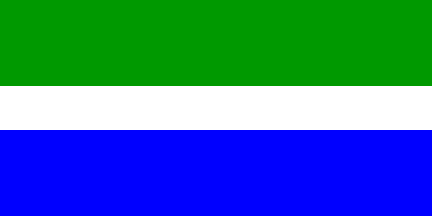
image by António Martins-Tuválkin, 14 September 2010

Last modified: 2014-05-29 by zoltán horváth
Keywords: livonian people | latvia | baltics |
Links: FOTW homepage |
search |
disclaimer and copyright |
write us |
mirrors

image by António Martins-Tuválkin, 14 September 2010
See also:
The Norwegian newspaper Aftenposten carried an article on
23-JUN-1996 about the Livonians. This is a small people native to
Latvia, living in on the northern tip of the 'peninsula' between
the bay of Riga and the Baltic sea. They are only 250-300 people
today in Latvia, and only 11 worldwide speak the language as
their mother tongue. Livonian is a Finno-Ugric language that was
codified into a written standard only in 1935.
The flag of the Livonians, as shown on a picture and drawing in
Aftenposten, is striped green over white over blue (the colours
were a bit pale). The middle white stripe seems to be narrower
than the stripes above and below, as in the Latvian national
flag. Nothing is said about the symbolism or when the flag dates
from. However, Aftenposten describes the land of the Livonians as
"a natural paradise of green forest, white beaches and blue
sea", so that may be a clue. Judging from the newspaper
photograph and illustration, the flag is 1:2 in proportions.
Jan Oskar Engene, 24 June 1996
The Livonian flag was approved at the first meeting of the
Livonian Association on April 2, 1923. The flag's colours were
chosen because of their close relationship with everyday life
that most Livonians led. Blue symbolises the sea, white the sandy
beaches characteristic of the area the Livonians inhabit, and
green the forest. The size of the stripes is the same as on the
Latvian flag, in a ratio of 2:1:2. The flag was blessed and
raised for the first time on November 18, 1923, at the Livonian
festival in Ire (or Mazirbe, in Latvian).
Uldis Balodis , from the Livonian
home page
This flag is listed under number 82 at the chart "Flags
of Aspirant Peoples" [asp] as :
"Livians (Livonians) - West Latvia."
Ivan Sache, 18 September 1999
I thought that Livonian is (was?) a Baltic language, like
Latvian and Lithuanian, not a Finno-Ugrian language like
Estonian, but <www.pinette.net>
shows it as Finno-Ugrian. We may have been confused because
it survives only as a second language of some dozens of Latvians,
all of them getting on in years.
John Ayer, 7 October 2000
It is in fact a Finno-Ugric language which seems to be on the
brink of extinction. However, it's been that way for more than
100 years!
I translated a quote from the book published in 1998
"Maailman kielet ja kielikunnat" (The World's Languages
and Language Families), by Jaakko Anhava, a Finnish linguist:
"The most southern Baltic-Finnic language, and the one that
differs most from the others, is Livonian, which has, like Vote,
almost vanished; there might remain under 20 speakers. Historical
"Livonia" got its name from the Livonians - actually
Livonia's East Livonian dialect had already died out in the last
(i.e., 19th) century. The remaining West Livonian speakers live
in Kurland (west of the Bay of Riga); their village society had
splintered in the turmoil of the Second World War, and the
collectivization of the Soviet Era attended to them. The
Livonians have, over the centuries, assimilated primarily to the
Latvians, but their traditional settlement area has been such,
that the Livonian language has left a large sub-stratum influence
in Latvian (which belongs to a quite different language family,
Indoeuropean); many features of Latvian which differ from its
near relative, Lithuanian, are a result of just this sub-stratum.
On the other hand, the influence of Latvian has moved the
phonetics, morphology and vocabulary of Livonian to a position in
the Baltic-Finnic languages most remote from the others."
I actually own a recently published Latvian grammar/textbook in
Finnish. In a chapter on Livonian, the book mentions that
Livonians have the right to demand elementary school education in
their own language!
Lewis A. Nowitz, 7 October 2000
The map at <www.ingyennet.hu/~latvija/liv.htm>
shows all of the villages (12) of "The Livonian Coast"
which was made by the Government of Latvia in 1991. On the
picture there is The Livonian House.
On the house there is a inscription: This house was built by
Livonian People with the help of their country - Latvia and their
brother nations: Finns, Estonians and Hungarians.
István Molnár and Georges Kovari, 27 March
2001
The Livonian tricolor flag, green-white-blue, makes a
clar reference to the national flag by means of its unique geometry of
2+1+2 (something impossible in, say, Germany or Italy).
António Martins-Tuválkin, 14 September 2010